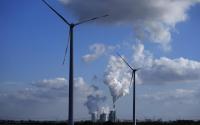21 May 2007Planet ArkJames Grubel
But the government said more rains were needed to break the drought.
Widespread falls were recorded across New South Wales state, where drought has hit about 80 percent of farmland, and the southern state of Victoria, with more autumn rains forecast over coming days.
In the town of Bourke, about 800 km (500 miles) north west of Sydney, more than 70 millimetres (2.7 inches) fell in the 24 hours to mid-Friday, turning dusty fields to mud and lifting the spirits of struggling farmers.
"It's certainly put a smile on a lot of faces and created some optimism for the future. Things have been so dry out here for the past seven years," Wayne O'Mally told Reuters from his farm, northeast of Bourke.
Up to 66 mm rains fell in parts of Victoria.
Prime Minister John Howard welcomed the latest downpours, but said much more was needed to break the drought for most farmers.
"Some of them haven't had decent rain for seven years, and we can't overestimate the morale boost that this will represent," Howard told reporters in the northern tropical city of Townsville.
"But we have got to keep hoping and praying for more rain because they will need more than the falls of the past 24 or 36 hours to break the drought."
The downpours came as towns along the country's rivers prepared to impose strict restrictions on water use due to record low river inflows. The government has said there may be no water for irrigation without substantial winter rains.
Inflows into the nation's foodbowl along the Murray-Darling basin remain at record lows, with the government setting aside A$3 billion (US$2.5 billion) over 10 years to buy back water allocations due to the ongoing drought.
The river basin, the size of France and Spain, accounts for 41 percent of Australia's agriculture, 90 percent of irrigated crops and A$22 billion worth of agricultural exports.
Like many other farmers in western New South Wales, O'Mally, who is mayor of the Bourke regional council, has run down his sheep flock and cattle herd, and has been forced to buy in feed.
He said more follow up rain was needed to guarantee feedstock and help secure winter crops.
"We won't need a lot of rain, but we'll certainly need that half inch to an inch of follow up rain to get the country going," O'Mally said.
Figures from the Australian Bureau of Statistics showed sheep flock fell to an estimated 91.9 million in the year to June 30, 2006, down 10 percent on the previous year, due to destocking and farm deaths because of drought, representing the lowest level since 1925.
Australia's worst drought in 100 years in 2002 and 2006 cut wheat crops by 60 percent to around 10 million tonnes, while other grain crops, including barley and canola, were severely cut.
The New South Wales Farmers Association president Jock Laurie said the latest rains were widespread across the state, but strong follow ups were needed and it was too early to say the drought would soon be over.
"We've had some really good falls right across the state and it really is encouraging," Laurie told Reuters. "But there's been some massive losses over the past five years. It's going to take a long while to get people on the road to recovery."
(US$1=A$1.21)






